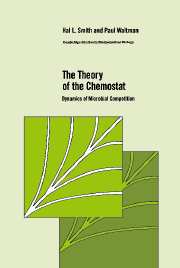Book contents
- Frontmatter
- Contents
- Preface
- 1 The Simple Chemostat
- 2 The General Chemostat
- 3 Competition on Three Trophic Levels
- 4 The Chemostat with an Inhibitor
- 5 The Simple Gradostat
- 6 The General Gradostat
- 7 The Chemostat with Periodic Washout Rate
- 8 Variable-Yield Models
- 9 A Size-Structured Competition Model
- 10 New Directions
- 11 Open Questions
- Appendices
- References
- Author index
- Subject index
5 - The Simple Gradostat
Published online by Cambridge University Press: 07 December 2009
- Frontmatter
- Contents
- Preface
- 1 The Simple Chemostat
- 2 The General Chemostat
- 3 Competition on Three Trophic Levels
- 4 The Chemostat with an Inhibitor
- 5 The Simple Gradostat
- 6 The General Gradostat
- 7 The Chemostat with Periodic Washout Rate
- 8 Variable-Yield Models
- 9 A Size-Structured Competition Model
- 10 New Directions
- 11 Open Questions
- Appendices
- References
- Author index
- Subject index
Summary
Introduction
In the preceding chapter we saw how the chemostat could be modified to account for a new phenomenon – the presence of an inhibitor. In this chapter we extend the idea behind the simple chemostat to a new apparatus in order to model a property of ecological systems that it is not possible to model in the simple chemostat. The idea is to capture the essentials of the new phenomenon without destroying the tractability of the chemostat either as a mathematical model or as an experimental one. A very simple situation will be described here; a more complicated one – with a less explicit (in the sense of less computable) analysis – will be discussed in the next chapter. Just as the chemostat is a basic model for competition in the simplest situation, the apparatus here shows promise of being the model for competition along a nutrient gradient.
The “well mixed” hypothesis for the chemostat does not allow a nutrient gradient to be generated. A basic tenet is that the nutrient concentration is the same everywhere; hence any advantage in nutrient consumption is present everywhere. The model that incorporates a true gradient would be one involving partial differential equations; a new variable, space, must be accommodated. Systems of nonlinear partial differential equations are difficult mathematical objects to understand and analyze. Even numerical solutions pose added and significant difficulties. Moreover, even if an experimental gradient is devised, measurements that do not disturb the local environment take on new difficulties.
- Type
- Chapter
- Information
- The Theory of the ChemostatDynamics of Microbial Competition, pp. 101 - 128Publisher: Cambridge University PressPrint publication year: 1995



